The Rise of Islam
The rise of Islam: the events between 632 and c.700 CE, when the Arabs conquered the Near East and exported on the one hand their Arabian identity and on the other hand their new monotheistic faith.
Summary
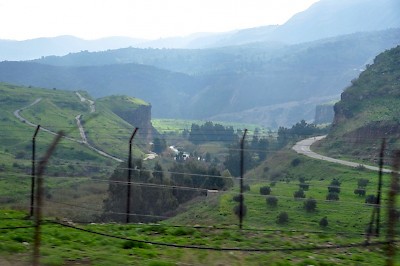
At first sight, the study of the origin and spread of Islam is comparatively easy. After all, the military campaigns are quite well-documented in Arabic, Armenian, Byzantine, Latin, Persian, and Syriac sources. Besides, the story itself is plausible: after a crisis that followed the death of the prophet Muhammad (632 CE), caliph Abu Bakr (r.632-634) restored order, and his successors Umar (r.634-644), Uthman (r.644-656), and Muhammad's son-in-law Ali (r.656-661) expanded the caliphate.
Notable events were the conquest of Mesopotamia (633-638), the invasion of Palestine and Syria (634), followed by the defeat of the Byzantine army, led by the emperor Heraclius, in the battle of the Yarmouk (636). The capture of important cities is well-documented: Damascus (634) and Jerusalem and Ctesiphon (both in 637). In the following years, the Arab armies invaded Persia (638-651), Egypt (639-641), Cyrenaica (642), and Tripolitana (643). During the next decades, the frontiers of the Arab Empire would be further expanded to the Pyrenees and the Pamirs, which are about 6,500 kilometers apart.

After the death of caliph Ali, who was the son-in-law of the prophet, the family of Muhammad lost influence, and it was the relatives of Uthman, the Umayyad family, who established the Caliphate of Damascus and started to organize the conquests. Because the generation that had personally known Muhammad now came to an end, the traditions of Islam were collected: the codification of the Quran is generally attributed to caliph Uthman, and the hadith (the stories about the exemplary life of the prophet) were written down as well.
Two Problems
All this is well-documented. We know what happened, but we do not understand why it happened. Since the caliphate expanded to a length of 6,500 kilometers in just 120 years, it would be interesting to identify the “motor” behind the incredible speed of 55 kilometers per year. It cannot have been religion, because it is impossible to convert the population of such a big region in such a brief period. The extreme speed of the conquest suggests that something else was going on and that our sources merely record the events at the surface, leaving a deeper cause unmentioned. That was our first question.

The second one: what was Islam at this very early stage? Phrased differently, this is the problem of Muhammad’s teachings. A historian cannot accept divine intervention in the course of history but may accept the Islamic stories, leaving out the miracles. This has been the approach of French orientalist Maxime Rodinson (1915-2004), who presented Muhammad as a social revolutionary. However, we are allowed to ask for something more critical than “believe everything in the sources, unless the laws of nature are suspended”.
Another approach is to ignore all Arabic sources. After all, they were written quite late, a century after the conquest. It is generally accepted that the creation of Islam as we recognize it was a separate process, which took place after the Arab conquests had created the caliphate. (Muslims say that some implications of their faith were understood only after the death of the prophet.) Only after c.690, when it became clear that Arab monotheism was incompatible with Byzantine trinitarianism, Islamic scholars started to develop Islamic law and doctrine. This does not mean that there was no Islam in the preceding period, but it was still very loosely defined and we cannot know how much continuity there is between this early, charismatic phase and the later, scholarly phase. However that may be, the main questions and themes had changed when the Arabic sources were written in the eighth century. This is a serious complication and modern scholars like the Danish-Amercian orientalist Patricia Crone (1945-2015), have had a low view of the sources’ reliability. These revisionist scholars have tried to describe the rise of Islam while focusing on non-Islamic sources.
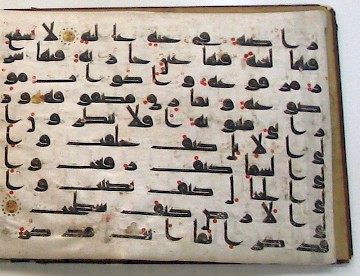
The twenty-first century has given rise to a third approach: that Islam started as a Monophysite Christian sect. This implies that the Quran was not written in Arabic, but in a mixture of Syriac and Arabic. This is less far-fetched than it seems, because eastern Syria was very important for early Islam, and the Quran is indeed written in a script without vowels. Worse, it was possible to interchange even consonants. (Before the Arabs placed dots on and under their letters, the signs for e.g. b, t and th could easily be confused.) As a consequence, there is some room for a different reading of the vocals and the consonants.
This “Luxenberg Thesis” does indeed help solve some minor problems, but saddles us with a new, big problem: we must assume that there has been a time in which the Quran was not recited, so that the believers could forget the original language. It will be obvious that is highly controversial and not based on sound scholarship, but it gained much attention after the Islam-inspired terrorist attack on the World Trade Center in New York (2001).
We are left with two problems:
- The Arab conquests need an explanation; we will rephrase the question below.
- Because important sources were written after the phase of Arab conquests (with a loosely defined Islam), during a second phase in which Islam received its formal doctrine, it is complicated to establish Muhammad’s teachings and we do not know to which belief people converted. Still, we will make an attempt below.
The Conquest
It is tempting to accept the story in the Arabic sources that the Arab conquests were caused by a new faith. Inspired by Islam, the believers were able to overcome every enemy. However, it is reasonably clear that the formative period of Islam was after the conquests. (As indicated above, Muslims think that the implications of their faith were understood only after the death of the prophet.) This does not mean that religious zeal played no role at all, but the historian cannot close his eyes for the fact that Christians fought in the Arabian armies and Zoroastrians could be tax collectors. Something else was going on.
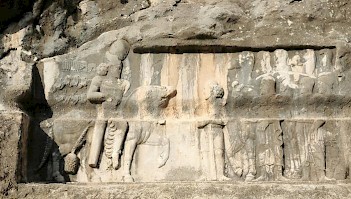
It had started long before. The Incense Route had brought together the various parts of the Arabian Peninsula: the cities in what is now Yemen, the towns and tribes along the route to the northwest (e.g., Yathrib, Dedan, Hegra, Tayma), and the Ghassanid and Lakhmid federations along the urban periphery of the Roman/Byzantine and the Sassanian Empires. For example, the mundane inhabitants of the cities in the deep south, who had despised the Arabs (“nomads”), had started to identify themselves like the other inhabitants of the peninsula. In a related process, Arab groups had infiltrated the urban periphery: the Nabataeans had settled in Edom, the Itureans had created a small state named Chalcis in the Bekaa valley, other Arab groups had settled in Palmyra and the other towns on the rim of the Syrian desert. The Arab expansion had started long before Muhammad.
A second process was the rise of monotheism on the Arabian Peninsula. The Tayma Oasis had a Jewish minority and the kingdom of Himyar in Yemen for several years had a Jewish government. The fact that it persecuted Christians is evidence for the presence of this monotheistic faith as well. Even more important were the monotheistic (“Abrahamite”) reforms that had taken place in the Kaaba in Mecca in the mid-sixth century, called the Hums.note Although many Muslims believe that Muhammad introduced monotheism, he may in fact have introduced a cultic reform within a henotheistic sanctuary.
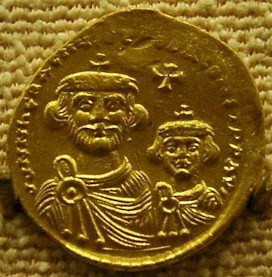
In short, a monotheistic expansion from the Arabian Peninsula was in the making and its chances were greatly improved when the Sassanian Persians attacked the Byzantine Empire. This war was to last for a quarter of a century, from 602 to 628. It looked as if the world was coming to an end and God was coming to judge the nations, especially after the Persians had captured Jerusalem and taken the True Cross. Christian and Jewish texts document the rise of eschatological and Messianic speculations. At first, the Sassanians seemed to win this war, but the Byzantine emperor Heraclius managed to turn the tables and defeated the Persians, who never recovered.
However, the Byzantine Empire, although victorious, was seriously weakened as well. There had always been Christians who believed that worshiping Christ implied that one could not at the same time worship other deities. The conversion of the emperor Constantine the Great (r.306-337) gave these Christians support and although there were non-exclusivist Christians for at least a century to come (e.g., Bacurius), protecting the one true faith was now the responsibility of the emperor. This meant that the state could enforce orthodoxy, and the emperors of the fifth and sixth centuries were often involved in ecclesiastical matters. Religious conflicts could and did escalate, seriously weakening the empire. When the Arabs invaded Egypt (639 CE), they were welcomed by the Christian (Coptic) population, who detested the Byzantine government’s enforcing of the Creed of Chalcedon.
In other words, the question is not what caused the Arab expansion, but what caused the collapse of the Sassanian and Byzantine Empires. War and Christian infighting were major factors, essentially opening the gates for monotheistic Arabs.
Muhammad’s Teachings
Against the background of the war between the Sassanian Persians and the Byzantines, Muhammad experienced his first vision (610 CE). His revelations constitute the Quran and the message can be summarized in three sentences: there was only God, the day of Judgment was very close, only the believers would be saved. Because judgment would be individual, everyone had a personal relation to the Judge, which implied egalitarianism; and of course faith had to be sincere, which meant that there were rules for prayer.

Later authors, like Muhammad’s eighth-century biographer Ibn Ishaq, were convinced that the Meccans were idolaters and that the square surrounding the Kaaba (the haram) was filled with horrible idols, but this may be a pious belief, to make Muhammad’s ministry more spectacular: he had been a monotheist in a polytheist city. However, the Hums movement had already converted the Kaaba into a shrine for the cult that had been established by Abraham, which was monotheistic. The statues of the other gods had been removed from the haram. God’s only companions were three traditional Arabian goddesses, the “daughters of God” (Allat, al-‘Uzza, and Manat), who were messengers between heaven and earth. If Muhammad announced that there was only one God, few Meccans will have been surprised, and Ibn Ishaq says that
I have been told that when the messenger explained Islam as God had instructed him, the Meccans did not ignore or oppose him, until he started to speak disparagingly of their god.note
The second part of this sentence must refer to these daughters: their role as intermediaries must have been unacceptable for Muhammad, a more radical monotheist than his fellow-Meccans. If so, this must have been the reason for his exile to Yathrib in 622 CE (modern Medina).

Remarkably, this was the moment when the war between the Sassanians and Byzantine took an unexpected turn: Heraclius launched a successful counter-offensive. Suddenly, Muhammad, who had predicted the Byzantine victory while everybody was convinced that the Sassanians would win the war,note had the credentials of a true prophet. In Yathrib, Muhammad was recognized as the new local leader. He launched a war against Mecca, eliminated Jewish tribes that did not recognize him, returned to Mecca, cleansed the haram, and died in 632, having created a unified Arab state.
This is one possible reconstruction of the life and teachings of Muhammad. As indicated above, there are several theories, ranging between Rodinson’s faith in the general reliability of the sources (especially Ibn Ishaq’s Life of the Prophet of God) and Crone’s hyperskeptical approach. What seems reasonably certain, however, is that Muhammad promoted an Arab monotheism (different from the Jewish and Christian monotheisms) and that he believed that only monotheists would be saved on the day of Judgment.
This included those Jews and Christians who were willing to accept Muhammad’s leadership, which explains why we find Christian soldiers in the Arab armies and why conquest went so extremely rapid. It looks as if the Arab conquest was the surface of a deeper, essentially ecumenical, eschatological, monotheist tidal wave, created by an Arab prophet and for some time accepted by other monotheists.
The Dome of the Rock
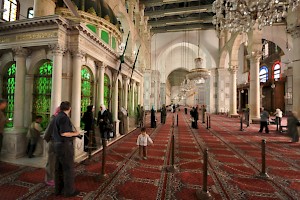
After the assassination of caliph Ali in 661 CE, power in the new Arab state was transferred back to the family of his predecessor Uthman: the Umayyads. Leaving the Arabian Peninsula, they took Damascus as their residence. Yathrib – now called al-Madinah an-Nabawiyyah, “the city of the Prophet” – remained the residence of the descendants of Ali (and Muhammad), who continued to claim leadership. The two competing families clashed in 680 in the battle of Kerbala, in which an Umayyad army defeated an army led by Ali’s son (and Muhammad’s grandson) Huseyn.
From now on unchallenged, the Umayyad leaders started to organize the caliphate. The armies continued their advance to the east and west, a system of administration was created, and places of worship were built. Until then, the believers had used existing churches: the Umayyad Mosque in Damascus, for example, used to be a Christian cathedral. One of the first real Islamic monuments is the Dome of the Rock in Jerusalem.
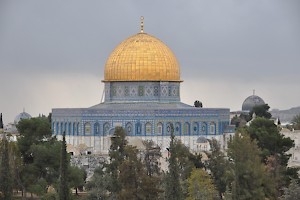
It contains an inscription with the Quranic verse “It is not befitting to Allah that He should take himself a child”,note which is a direct refutation of the Christian belief that Jesus was the son of God. Probably, the Muslims had started to understand that their radical monotheistic beliefs, which may well go back to Muhammad, were incompatible with the complex Trinitarian theology of Christianity. As an ecumenical, monotheistic movement, early Islam had come to an end.
The Rise of Islam
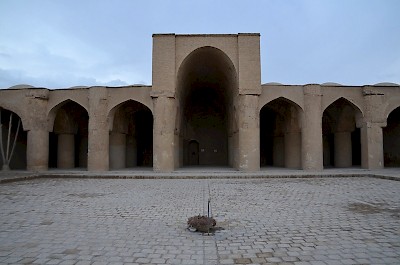
The next generations would see a gradual rise of the number of converts to what was now an indepent faith. They would also be witness to the construction of the first real mosques, to the creation of spectacular secular architecture – and to criticism. The four first caliphs (Abu Bakr, Umar, Uthman, Ali) were now called “rightly guided”, implying that the Umayyad caliphs were not rightly guided. The Persians continued to support the leadership of the family of Ali and Huseyn. Seen from a top-down perspective, Shi’ite Islam originated in a clash between two rival families; seen from a bottom-up perspective, it was the expression of Persian opposition to Arab hegemony and as such a remarkable form of Iranian nationalism.
There was another kind of criticism. The Umayyads usually left the laws and customs of the subject nations unchanged and created an essentially secular state. Pious Muslims objected. The Quran and the hadith had to guide the faithful. Their pursuit of a truly Islamic way of life marks the beginning of a new phase in the history of the caliphate: an Arab state had been created, from now on it would become increasingly Islamic.
Literature
There is a lot of modern literature on the rise of the Arab state and Islam. Maxime Rodison's Mahomet (1961) and Patricia Crone's revisionist Hagarism (1977) approach the subject matter from completely different angles. A balanced book that avoids the extremes is Muhammad and the Believers (2010) by Chicago scholar Fred Donner. The unification process among the Arabs prior to the rise of Islam is the subject of Robert G. Hoyland, Arabia and the Arabs (2001).







